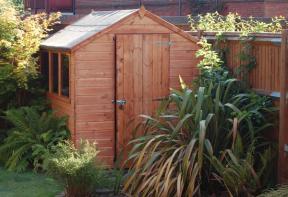Pick the right shed for your yard
Everything you need to know about the backyard essential before you build
When it comes to sheds, the possibilities are endless–a humble building just big enough for a lawnmower and a massive, garage-wannabe shed can often be found on the same neighbourhood block. So how do you choose the right shed for you?
The first thing to consider is your shed’s purpose. Is it a place to stash your lawnmower, or do you need to squeeze outdoor furniture, bikes and tools in there, too? Do you only need it for storage, or do you want to transform it into some type of workshop?
Once you have a good idea of how you’ll be using your shed, you have a choice: build your own shed from your own design or buy a pre-fab shed kit.
Pre-fab sheds
Pre-fabricated shed kits are the easiest way to get some extra storage without too much time or hassle. While your options may be limited (most models are gable roofs and pretty small), you will be able to assemble the shed in less than a day. The other advantage of choosing a pre-fab shed over building one yourself is portability; a pre-fab shed can generally be moved around the yard, whereas a DIY shed is generally a more permanent fixture.
How to design a shed
“Since they’re small, sheds are one of the few things that almost any homeowner can afford to lavish first-class care and materials on,“ says Steve Maxwell, Canadian Home Workshop’s technical editor. And while many homeowners may scoff, ‘It’s just a shed,’ quality of design and materials is crucial to building a shed that not only stands the test of time, but also looks at home in your yard: “No matter how well you build it, your shed will still be an eyesore if it looks like something cooked up by Red Green,” Maxwell cautions.
The easiest way to design a shed is by using graph paper and setting a scale. For example, each square can equal one square foot–or something to that effect. Another method is to use software to design your shed. Once you’ve sketched out your plan, use the scale to determine the materials you need; it also wouldn’t hurt to look at books dedicated to building sheds or other buildings, to make sure you are designing the shed with enough structural support for the roof or other features.
Sheds can range in size from tiny to massive, but most backyard sheds will be a medium size, 10’ x 10’ or thereabouts. Once you have a rough idea of what you’ll be using it for, you’ll have a good idea of what kind of building materials you require.
When designing your shed, there are many things to keep in mind. We’ve broken down the myriad choices for you:
Roof style
Given the small size of most sheds, the roof you choose can add more than just panache to your creation.

Gable This is the most common type of roof, as it is the easiest to construct. This roof consists of two sloping sides that meet at a peak.
Best for: Storage. Limited headspace makes this a perfect model for organizing equipment and tools against the walls.

Gambrel This popular roof type resembles a barn, with either five or more sloped sides forming a domed roof.
Best for: Mixed use. The addition of a loft doubles the storage capacity or allows more floor space for a work area.
 Lean-to This shed type is often built against the side of an existing structure. The roof is simple, consisting of a single side that slopes downwards.
Lean-to This shed type is often built against the side of an existing structure. The roof is simple, consisting of a single side that slopes downwards.
Best for: Storage. Lean-to sheds are often small and don’t leave much room for anything other than parking equipment.

Saltbox Much like a gable roof, a saltbox roof consists of two sloping sides. In this case, the sides are uneven in size and pitch, with one side being smaller and at a higher pitch than the other.
Best for: Mixed use. The difference in headspace allows the shed to function as both a storage area and a work area.
Jump to a section
- Page 1 : All about sheds
- Page 2 : Foundation and materials options
To leave a comment, please log in












No comments